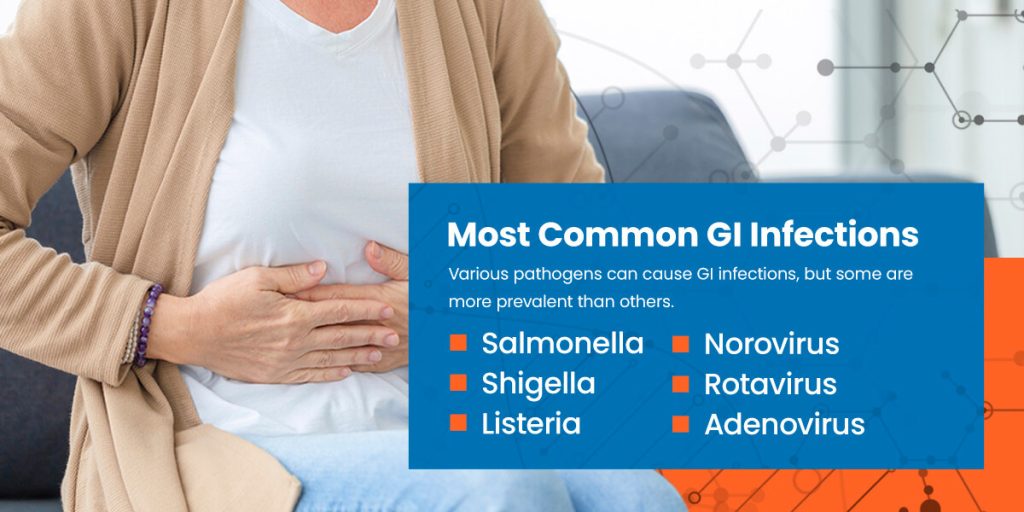Gastrointestinal (GI) infections encompass a wide range of etiologies, presenting various clinical challenges for both patients and health care professionals. Accurate identification and appropriate management of these infections are crucial for patient well-being and public health. Although the majority of intestinal infection cases resolve spontaneously in a few days, certain patient populations may experience more severe or prolonged symptoms, necessitating targeted intervention. Differentiating between various types of infections in the digestive tract is crucial to optimize patient outcomes and provide effective treatment when it is essential.
Types of Stomach and GI Infections
An intestinal infection can be broadly classified into three groups according to the etiological agents:
- Bacterial: Common bacterial pathogens include Staphylococcus aureus and Escherichia coli (E. coli). These microorganisms contaminate food products, such as raw meat, unpasteurized dairy, and unwashed fruits. Infected individuals can also spread bacteria to the food they touch, further spreading the infection. Bacterial infections typically respond well to antibiotic therapy.
- Viral: Unlike bacterial infections, viral infections are often more contagious and can spread through air and surfaces. Antibiotics are ineffective against viral pathogens.
- Parasitic: Parasites rely on a human host to survive. The eggs of these parasites can live in water or in soil. When a person comes in contact with these eggs, the parasites have a living organism to use as a host. Parasites can also be treated with antibiotics.
Symptoms of a Gut Infection
Regardless of their underlying etiology, GI infections often present with similar clinical features, including:
- Nausea
- Diarrhea
- Vomiting
- Stomach cramps
- Fever
- Muscle aches
- Loss of appetite
- Unintentional weight loss
Dehydration and electrolyte imbalances may also occur, especially in patients with frequent diarrhea. Signs of dehydration include dark urine, dry mouth, and fatigue.
Bacterial infections typically present with higher fevers and hematochezia in comparison to viral infections. Parasitic infections often manifest with the presence of blood or mucus in diarrhea, which may resolve spontaneously. However, consultation with a physician for appropriate management of parasitic infections is recommended for optimal resolution.The clinical presentation of GI infections may differ in severity, with symptoms generally persisting for up to a week. Certain populations are more susceptible to protracted infections. In these cases, medical intervention is recommended.
Most Common GI Infections

Various pathogens can cause GI infections, but some are more prevalent than others. The most common intestinal bacteria are salmonella, shigella, and listeria. Viral infections often involve norovirus, rotavirus, and adenovirus.
Salmonella
Salmonella is one of the most common intestinal bacterial pathogens. It lives in human and animal intestines and sheds through stool. The bacteria can contaminate various types of foods, including eggs, pork, chicken, fruits, sprouts, and vegetables. When foods are contaminated with salmonella, they typically smell and look normal, making it challenging to identify contaminated foods.
When infected with salmonella, some individuals may not experience any symptoms. Clinical manifestations typically include fever, stomach cramps, and diarrhea, though some groups are more at risk for severe symptoms such as bloody stool or dehydration. Salmonella infections — salmonellosis — usually last a few days, but if they last longer, medical treatment is recommended.
Shigella
Shigella is a bacterial species with four subgroups — S. dysenteriae, S. flexneri, S. boydii, and S. sonnei. The most common subgroup of shigella in developed countries is S. sonnei, though S. dysenteriae and S. boydii continue to cause disease in areas with fewer resources.
Only a small number of shigella bacteria is needed to cause illness, and it can originate from various sources, such as:
- Swallowing or swimming in contaminated water
- Eating food prepared by someone with a shigella infection
- Touching surfaces with small amounts of shigella bacteria
- Caring for someone with a shigella infection
Much like salmonella, shigella causes fever, diarrhea, and stomach pain. Shigella may also cause bloody or prolonged diarrhea that lasts for more than three days. An additional clinical manifestation is the feeling of needing to pass stool even when the bowels are empty.
Listeria
Listeria is a bacteria that causes listeriosis, and it most commonly affects newborns, pregnant women, older adults, and immunocompromised individuals. People in other groups may be infected with listeria without falling ill.
Clinical presentations may vary based on the patient population. For pregnant women, listeria causes a mild illness that creates flu-like symptoms such as muscle aches and fatigue. For other at-risk groups, symptoms can include headaches, stiff neck, loss of balance, and convulsions in addition to flu-like symptoms.
Most people contract listeriosis through contaminated food. Listeria thrives in moist environments like soil and water and can survive food processing.
Norovirus
Norovirus is a group of viruses that cause gastroenteritis, also known as stomach flu. This group of viruses includes several strains that cause inflammation in the stomach and intestines. There are 48 types in 10 groups, but GII.4 is the most common.
The virus spreads through contaminated foods or surfaces and can pass from person to person. In the U.S. alone, norovirus is responsible for 2.27 million outpatient clinic visits, most of which are for young children.
Vomiting is a prominent manifestation of norovirus, accompanied by symptoms such as nausea, diarrhea, and abdominal discomfort. Additionally, some cases of gastroenteritis may present with headache and fever. Most infections last from one to three days.
Rotavirus
Rotavirus is a highly contagious viral infection that spreads from person-to-person contact. The virus is stable in the environment, so it can also contaminate food, water, and surfaces. Infected individuals shed the virus through their stool, and unwashed hands or unclean surfaces can pass the virus to someone else. Typical symptoms are vomiting and diarrhea.
Children and infants are the biggest groups affected by rotavirus. Over 125 million cases of diarrhea are caused by rotavirus in children and infants worldwide. The rotavirus vaccine can reduce the likelihood of infection and reduce the severity of the infection. The first dose of this vaccine is given to infants before 15 weeks of age.
Adenovirus
Adenoviruses can cause a wide range of illnesses, including:
- Conjunctivitis (pink eye)
- Acute bronchitis
- Pneumonia
- Common cold or flu-like symptoms
Adenoviruses can also cause acute gastroenteritis. These viruses infect people of all ages and can pass via person-to-person contact, touching infected surfaces, through an infected person’s stool, or through the air. Many adenovirus infections are mild and can be managed with rest and over-the-counter medications.
Detect and Identify GI Pathogens With Applied BioCode Inc.
Given the overlapping clinical presentations of different GI infections, health care providers require reliable diagnostic methods to differentiate between etiologies. Timely and accurate detection can guide appropriate management strategies, ensuring patients receive the necessary care for recovery.
At Applied BioCode Inc., our FDA 510(k) cleared gastrointestinal pathogen panel is designed to detect and identify 17 gastrointestinal pathogens in a single sample. This diagnostic tool facilitates clinical decision-making and enhances overall efficiency and accuracy in patient care. With 17 targets in a single sample, you have the results you need with a system that supports clinical efficiency. Contact us today to learn more about our clinical diagnostic products.



